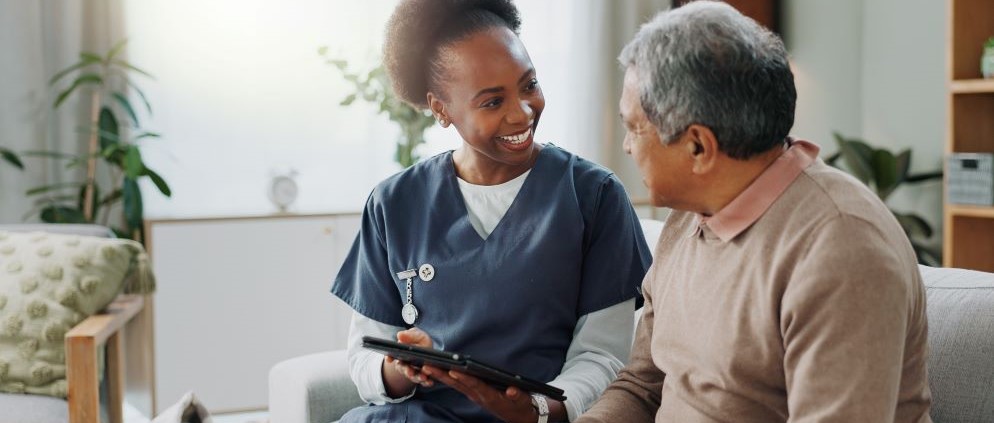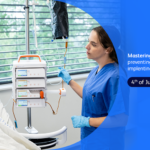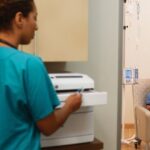Home infusion: Italy’s H-VAS programme supports PICC care at home
Italy has one of the highest percentages of older adults in the European Union,1 with approximately 24% of the current population over the age of 65.2 At the same time, cancer incidence is increasing in the elderly population more than in the young population.3
In Italy, several government initiatives focus on improving support for family caregivers and personal helpers who provide care in the home setting, as well as programmes aimed at providing greater support to elderly and dependent persons being cared for at home.4
Strengthening home care is one of the goals of the care model outlined in Italy’s National Plan for Recovery and Resilience,5 which sets out a plan to increase the volume of services rendered in home care, targeted to patients over the age of 65 with one or more chronic and/or dependent conditions.5 One of the goals is to maximise the benefits of technologies including telemedicine, home automation and digitisation.5
This is echoed in the Europe’s Beating Cancer Plan,6 which highlights the important role of family and informal carers, and the toll taken on them in terms of the time required for care activities, and potential loss of income due to reduced work availability.6
Study shows no significant difference in PICC complications for inpatients vs. home infusion patients
Dr Pinto shared the results of a study by Mielke et al who retrospectively analysed 522 PICC placements in 484 radiation oncology patients for complications and treatment- and patient-related factors during ambulatory and hospital inpatient use.7 The study showed that complications can occur both in inpatients and outpatients, but no significant difference in the number of complications was detected between the two groups.7
Complications were similar between the cohort of outpatients (3.6 per 1000 catheter days) and the cohort of inpatients (4.8 per 1000 catheter days.)7 The ambulatory patients received weekly PICC care, while the PICCs of inpatients were checked for complications at every drug delivery.7 “In cancer patients, the peripherally inserted central venous catheter is feasible and safe if routine care and management are planned,” said Dr Pinto.
Dr Pinto also shared the results from a qualitative content analysis on the supportive care needs of adults living with a PICC at home.8 This study showed that caregivers play an integral role, and that it is vital to include them in clinical education programmes, and support them so they can fulfil this role.8
More on this topic: PICC line or port catheter: Which one for cancer patients?
Home infusion programme developed to support cancer patients at home
Dr Monica Pinto, Director, S.C Rehabilitation Medicine, Istituto di Ricovero e Cura a Carattere Scientifico (IRCCS), National Cancer Institute “G. Pascale” Foundation, Naples, Italy, cited these challenges for care providers as key factors in the development of the Home Vascular Access System (H-VAS) programme, launched in Naples, Italy.
Dr Pinto presented an overview of the H-VAS programme at the 8th World Congress on Vascular Access (WoCoVA), held 17 – 19 April 2024 in Prague, Czech Republic. “Quality of life is the most important measure of outcome in chronic diseases such as cancer,” said Dr Pinto.
Become a VAMbassador to get access to the full article
References
1 Eurostat Statistics Explained. Population structure and ageing. Published February 2024. Accessed November 11, 2024.
https://ec.europa.eu/eurostat/statistics-explained/index.php?title=Population_structure_and_ageing
2 ISTAT Istituto Nazionale di Statistica. Resident population by sex, age and marital status as of 1 January 2024. Published 2024. Accessed October 25, 2024. Available at: http://demo.istat.it/popres/index.php?anno=2021&lingua=ita.
3 International Agency for Research on Cancer. Cancer Tomorrow. Available at: https://gco.iarc.who.int/tomorrow/en. Accessed October 16, 2024.
4 OECD Directorate for Employment, Labour and Social Affairs & OECD Trento Centre for Local Development. Towards Person-Centered Integrated Care in Italy: Inception Report. Published 2023. Accessed 17 October 2024.
5 Government of Italy. Italy National Recovery and Resilience Plan (PNRR). Published 2021. Accessed 17 October 2024.
https://www.italiadomani.gov.it/en/strumenti/documenti/archivio-documenti/national-recovery-and-reslieince-plan.html
6 European Commission. Europe’s Beating Cancer Plan. Published 2021. Accessed 17 October 2024. https://health.ec.europa.eu/system/files/2021-02/eu_cancer-plan_en_0.pdf
7 Mielke D, Wittig A, Teichgräber U. Peripherally inserted central venous catheter (PICC) in outpatient and inpatient oncological treatment. Support Care Cancer. 2020;28(10):4753-4760. doi:10.1007/s00520-019-05276-0
8 Sharp R, Xu Q, Pumpa R, et al. Supportive care needs of adults living with a peripherally inserted central catheter (PICC) at home: a qualitative content analysis. BMC Nurs. 2024;23(1):4. doi:10.1186/s12912-023-01614-0
9 Scienza e Farmaci. Istituto Pascale. Progetto Hvas: un operatore sanitario guida in teleassistenza i caregiver dei pazienti oncologici. quotidianosanita.it. Published June 19, 2024. Accessed August 7, 2024. https://www.quotidianosanita.it/scienza-e-farmaci/articolo.php?articolo_id=122928
This list of references to third-party peer-reviewed material and the sites they are hosted on are provided for your reference and convenience only, and do not imply any review or endorsement of the material or any association with their operators. The Third-Party References (and the Web sites to which they link) may contain information that is inaccurate, incomplete, or outdated. Your access and use of the Third Party Sites (and any Web sites to which they link) is solely at your own risk.
This presentation was developed by the presenter, and the findings, interpretations, and conclusions contained or expressed with it do not necessarily reflect the views of BD. To the extent this presentation relates to specific products, such products should always be used in accordance with the relevant instructions for use and other product documentation. This content should not be copied or distributed without the consent of the copyright holder. For further information, please contact: GMB-EU-MDS@bd.com
BD-139118




